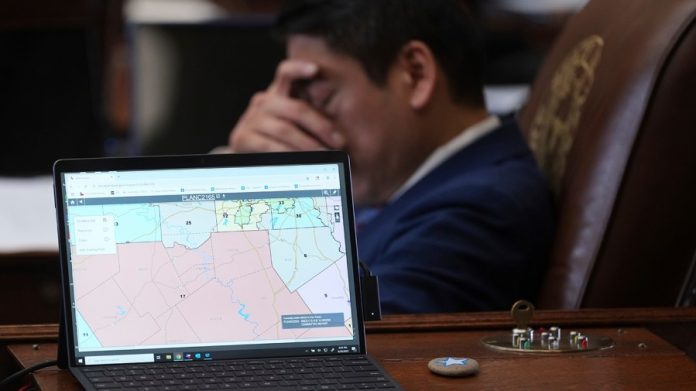
A handful of states have placed themselves front and center in a national redistricting battle after Texas took an unusual step to do mid-decade redistricting and advance a friendlier map for Republicans ahead of the 2026 midterms.
The Lone Star State’s map, which Texas Gov. Greg Abbott (R) signed into law on Friday, has prompted red and blue states alike to consider redrawing their own maps. California is the only state so far to tee up a potential new House map ahead of next year in response, where voters will weigh in November whether to pass new congressional lines.
The redistricting tit-for-tat will have major implications for which party controls the House – and whether President Trump could see a check on his power in Congress.
Here’s where key states stand on redistricting:
Texas
The GOP-led state legislature in Texas passed a new set of congressional lines this month, with the intent of giving Republicans the chance to pick up five seats in the midterms – an effort that was driven by Trump and the White House.
Abbott signed the map into law on Friday, but several organizations have already sued the state over the congressional maps, arguing that the map is unconstitutional and violates the Voting Rights Act.
A federal court has already scheduled dates for a preliminary injunction hearing in one of the lawsuits, which will run from Oct. 1 through Oct. 10.
California
California lawmakers advanced a new set of congressional lines aimed at neutralizing expected gains from Texas’ new map, with California Gov. Gavin Newsom (D) signing the bill.
The new House map will go before voters in a special election in November, where a simple majority is needed in order to enact the map before the midterms.
The California Supreme Court has rejected two challenges by Republicans over the new House map, but President Trump has said he intends to sue over them.
Ohio
The Buckeye State was originally the only state expected to redraw its congressional maps this year after the House map used in 2022 didn’t receive bipartisan support.
Republicans will be eyeing the chance to redraw Democratic Reps. Marcy Kaptur’s and Emilia Sykes’ seats to make them even more GOP-friendly. Kaptur’s seat is already Republican-favored, having gone for Trump by close to seven points in 2024 while Sykes’ district evenly split their votes between Trump and former Vice President Harris.
Republicans may also try to redraw Democratic Rep. Greg Landsman’s seat, though his will likely be harder to change given the seat includes Cincinnati.
The process to redraw the maps will begin in the coming weeks. The state legislature gets the first go at drawing the congressional lines, where lawmakers need to reach a certain threshold of bipartisan support in each chamber in order to pass a new map, with a deadline of Sept. 30.
If the state legislature can’t pass their House map with bipartisan support, the process is kicked over to the Ohio Redistricting Commission, which gets the chance to draw a map, with a deadline of Oct. 31. If the commission is unable to pass the map without bipartisan support, the state legislature gets another go at drawing the map, which must be passed by Nov. 30.
If the House map receives enough bipartisan support in the state legislature to pass, it’s used for the next decade. If the congressional lines don’t receive enough bipartisan support, they’re only in place for four years.
Indiana
The White House has been pushing for Indiana state lawmakers to redraw their House map, with Vice President Vance traveling to the Hoosier State earlier this month and later bringing up the topic with them again during their recent visit at the White House.
President Trump reportedly spoke with top statehouse leaders as well. While some Republicans initially opposed to the idea of redistricting have since come around, statehouse leaders and Indiana Gov. Mike Braun (R) have been noncommittal so far.
Braun is looking to statehouse leaders to see what kind of support redistricting has among the members.
Missouri
The White House has also been pressing top leaders in Missouri to redraw their map, and on Friday, Missouri Gov. Mike Kehoe (R) announced he would be calling a special session to convene starting Sept. 3 to consider redrawing the state’s House map.
“This is about clarity for voters and ownership of our future, and I hope the legislature will work together to pass our Missouri First Map and critically needed IP reform,” Kehoe said in a statement, with a press release including a House map his team made to be considered by state lawmakers.
Rep. Emanuel Cleaver (D-Mo.) in the state’s 5th Congressional District is most vulnerable here. But Republicans will have to be cautious in how they draw their map given the GOP ultimately nixed a plan in 2022 to draw a 7-1 map over concerns it could endanger some Republicans.
Florida
Florida Gov. Ron DeSantis (R) has signaled the Sunshine State should reconsider its House map ahead of 2026, and lawmakers are starting to take some steps in that direction.
Florida state House Speaker Daniel Perez (R) announced earlier this month that he would be creating a select committee on redistricting – a move that came about a month after the Florida Supreme Court upheld the state’s current map, which reconfigured former Rep. Al Lawson’s (D-Fla.) district, with three GOP lawmakers now holding parts of Lawson’s old district.
It’s unclear exactly when lawmakers are looking to meet and ultimately pass a new House map, though Perez noted that he would announce in September the members who would be included in the select committee.
Utah
The Utah Supreme Court delivered Democrats a win this month when it ordered the state to no longer use the congressional map the state passed in 2021.
It also determined that a ballot measure passed in 2018, which mandated the creation of an independent redistricting commission and was later repealed and replaced with a commission that was structured differently, was the law in Utah.
The state Supreme Court told lawmakers that it needed to redraw its map in compliance with the 2018 ballot initiative by Sept. 24. A hearing on the maps will be scheduled in mid-October.
The high court’s decision is likely to give Democrats one pick-up opportunity in the Beehive State.
Louisiana
Louisiana was required to create a second Black-majority district in the last election cycle after the Supreme Court cleared the way for the state to redraw its map following a Supreme Court case playing out in Alabama.
The Supreme Court was expected to issue a ruling over the congressional lines this summer after a group of “non-African American voters” sued over the new map, but in an unusual move, announced in June it would be rehearing the case. Oral arguments are scheduled for Oct. 15.
The question the Supreme Court is focusing on is “whether the State’s intentional creation of a second majority-minority congressional district violates the Fourteenth or Fifteenth Amendments to the U.S. Constitution.”
The state is urging for the high court to effectively throw out its current map, saying in a supplemental brief filed on Wednesday that the court should determine that “the intentional creation of a second majority-minority district in” the congressional map “is unconstitutional.”
“…the Court has assumed, but never decided, that race-based redistricting in the name of compliance with Section 2 of the VRA is constitutional,” the filing argues. “It is not for two independent reasons. First, race-based redistricting is categorically unconstitutional because it violates fundamental equal protection principles. Second, it fails strict scrutiny. Either way, race-based redistricting is unconstitutional.”
Alabama
One state to watch in the broader redistricting battle will be Alabama. A three-judge panel earlier this month ordered the state to use the map that Alabama used during the 2024 cycle, which was created by a special master and established a second Black-majority House district, for the remainder of the decade.
In a filing after the three-judge panel handed down its decision to use the congressional lines drawn by a special master, Alabama Republicans said they were appealing that decision to the high court.
Illinois
Illinois Gov. JB Pritzker (D) and Illinois Lt. Gov. Juliana Stratton (D) have left the door open to potentially redrawing the Prairie State’s House map, though there has been little movement publicly yet.
Democrats hold 14 of the 17 House seats in the district – a map that already gives a heavy partisan advantage to Democrats and which has been rated poorly by redistricting experts on partisan fairness and competitiveness.
Illinois and Maryland have easier paths to redrawing their maps as the states only need to pass new maps through the state legislature and are subject to the governor’s signature or veto.
Newsom has put pressure on states like Illinois and New York to begin taking up redistricting in their own states.
Maryland
Maryland Gov. Wes Moore (D) said last week that he’s actively looking at redistricting in his state, saying “all options are on the table.”
Maryland’s House Majority Leader in July proposed legislation that would allow the state to do mid-decade redistricting if another state initiated redrawing their maps first.
Redistricting the state is tricky enough given the Maryland congressional delegation includes seven Democrats and one Republican.
But Democrats would need to be especially cautious in trying to redraw their map given the one Democrats looked to use in the 2022 cycle – which essentially would have created eight Democratic-favored districts — was struck down by a court over partisan gerrymandering.
New York
Lawmakers in the Empire State have already introduced legislation that would amend the state Constitution to allow legislators to redraw their map if another state engages in mid-decade redistricting.
New York Democrats would need to pass that constitutional amendment in two consecutive legislative sessions before it goes to voters for a vote, meaning the Empire State wouldn’t be able to redraw its maps ahead of 2026 but could do so in the 2028 cycle.

